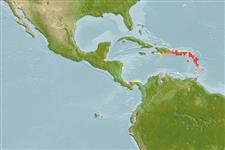>
Blenniiformes (Blennies) >
Chaenopsidae (Pike-, tube- and flagblennies)
Etymology: Emblemariopsis: Latin, emblema = insertion, inlaid work, raised ornament + Greek, opsis = appearance (Ref. 45335); carib: Named for the Carib native people of the Antilles; noun in apposition..
Environment: milieu / climate zone / depth range / distribution range
Ecologie
marien rifbewoner; diepte 5 - 15 m. Tropical
Western Central Atlantic: Hispaniola and the nothern Lesser Antilles.
Grootte / Gewicht / Leeftijd
Maturity: Lm ? range ? - ? cm
Max length : 1.5 cm SL mannelijk / geslacht onbekend; (Ref. 85868)
Korte beschrijving
Morfologie | Morfometrie
Dorsale stekels (totaal): 19 - 21; Dorsale zachte stralen (totaal): 10-12; Anale stekels 2; Anale zachte stralen: 19 - 21. This species is diagnosed by the following characters: TP territorial males found in holes with a black head and blackened anterior dorsal fin with a distal red band over a narrow white band and a thin white margin; first spine very long, when adpressed reaching to 8th-15th, equal or more than HL up ti 27% SL, second spine usually about 1/2-2/3 of first, third spine about 1/3-1/2 of first, the tenth spine at most 1/2 of first, anterior dorsal fin profile with a deep concavity since third and fourth spines are well shorter than subsequent spines (Ref. 125603).
Dark-shaded and pale TP with a similarly long first dorsal-fin spine and red band, sometimes several single scattered dark spots on the anterior spinous-dorsal-fin membranes, but not in a row; absence of opercular bands or lines, and of dark spots along lateral midline or above lateral midline (Ref. 125603).
IP has an elongated first two dorsal-fin spines, the first reaching to base of 6th-8th spine base when adpressed, the second slightly shorter, and the third half of first (earlier IP and juvenile with less elongate spines). Colouration: live colors include red, orange, and pink; cranial pattern with bands that are progressively breaking up and additional spots filling in: band 1 usually with two red spots; band 2 indistinct, with a few red spots and not a Y-shape; band 3 is most prominent, with thick red arms of a U breaking up into spots; band 4 thin and pale and pushed aside by red spots; band 5 with thick red segments; later pattern with red spots expanded to form a mosaic; IP head spots are dark and usually full complement; melanophores are near pectoral-fin base usually one to three spots, anterior spot often elongated obliquely (Ref. 125603).
Dark males photographed in holes in both live and dead corals, of several species and of different morphologies, including holes embedded among encrusting sponges. The IP individuals are mostly photographed on live coral substrate (Ref. 125603). Depth range given by B. Victor (pers. comm. 10/18).
Levenscyclus en paargedrag
Maturiteit | Voortplanting | Paaien | Eieren | Fecunditeit | Larven
Victor, B.C., 2020. Review of the glass blennies (Teleostei: Chaenopsidae: Emblemariopsis) with two new species from the Caribbean Sea. J. Ocean Sci. Foundation 37:1-122. (Ref. 125603)
Status op de Rode Lijst van het IUCN (Ref. 130435)
Gevaar voor de mens
Harmless
Gebruik door de mens
Meer informatie
Lokale namenSynoniemenMetabolismePredatorenEcotoxicologieVoortplantingMaturiteitPaaienPaaiaggregatiesFecunditeitEierenOntwikkeling van de eieren
Leeftijd/GrootteGroeiLengte-gewichtLengte-lengteLengtefrequentiesMorfometrieMorfologieLarvenLarvale populatiedynamiekRekruteringAbundantieBRUVS
ReferentiesAquacultuurAquacultuurprofielKweeklijnenGeneticaElectrophoresesErfelijkheidZiektesVerwerkingNutrientsMassaconversie
Tools
Speciale rapporten
Download XML
Internetbronnen
Estimates based on models
Fylogenetische diversiteitsindex (Ref.
82804): PD
50 = 0.5001 [Uniqueness, from 0.5 = low to 2.0 = high].
Bayesian length-weight: a=0.00457 (0.00183 - 0.01143), b=3.08 (2.86 - 3.30), in cm total length, based on LWR estimates for this (Sub)family-body shape (Ref.
93245).
Trofisch niveau (Ref.
69278): 3.0 ±0.4 se; based on size and trophs of closest relatives
Fishing Vulnerability (Ref.
59153): Low vulnerability (10 of 100).
